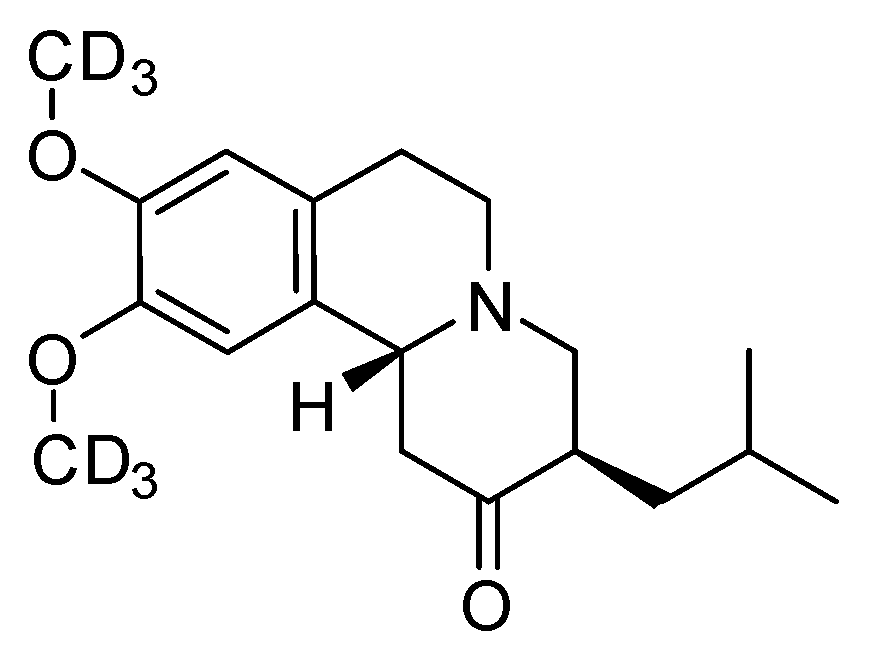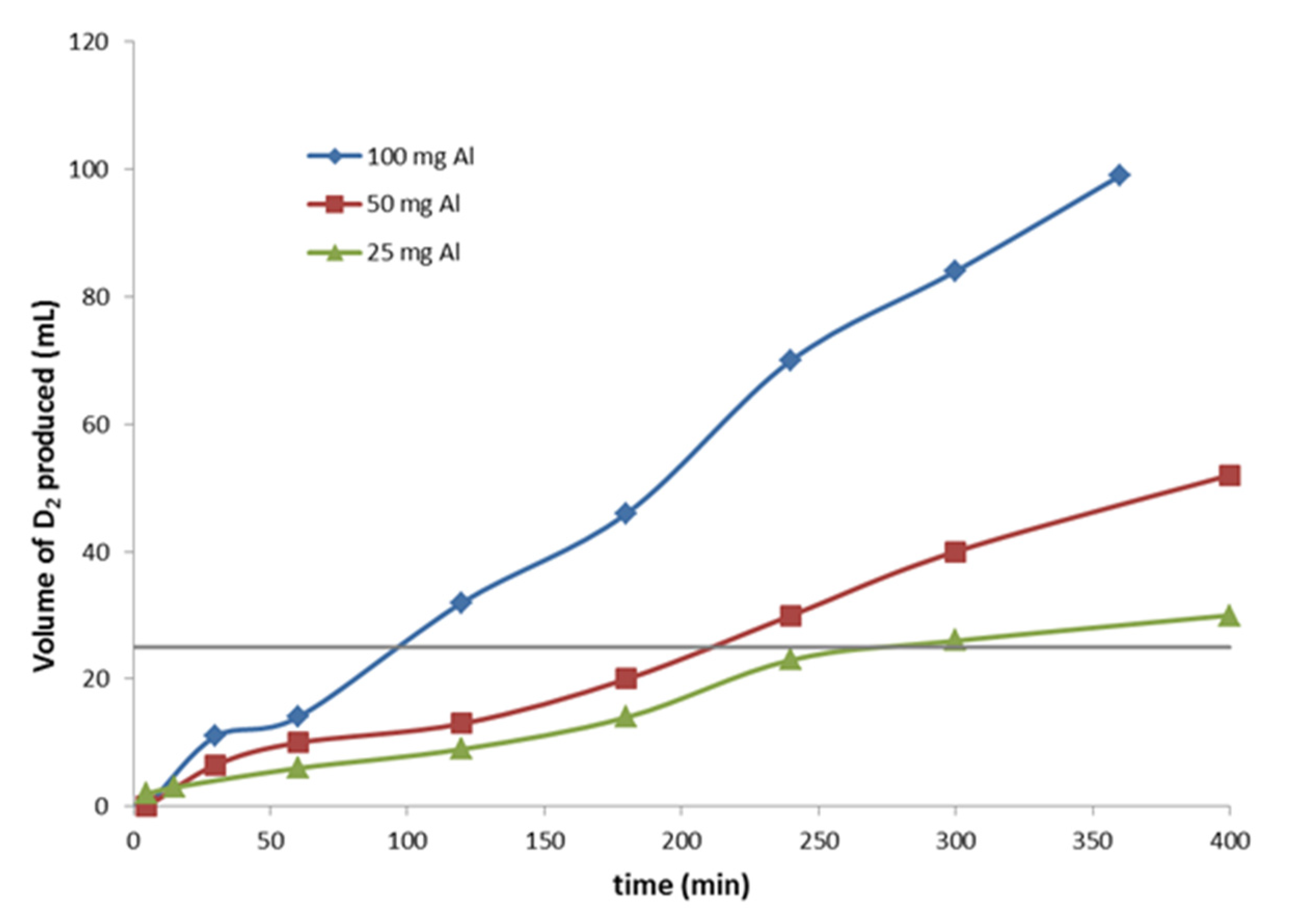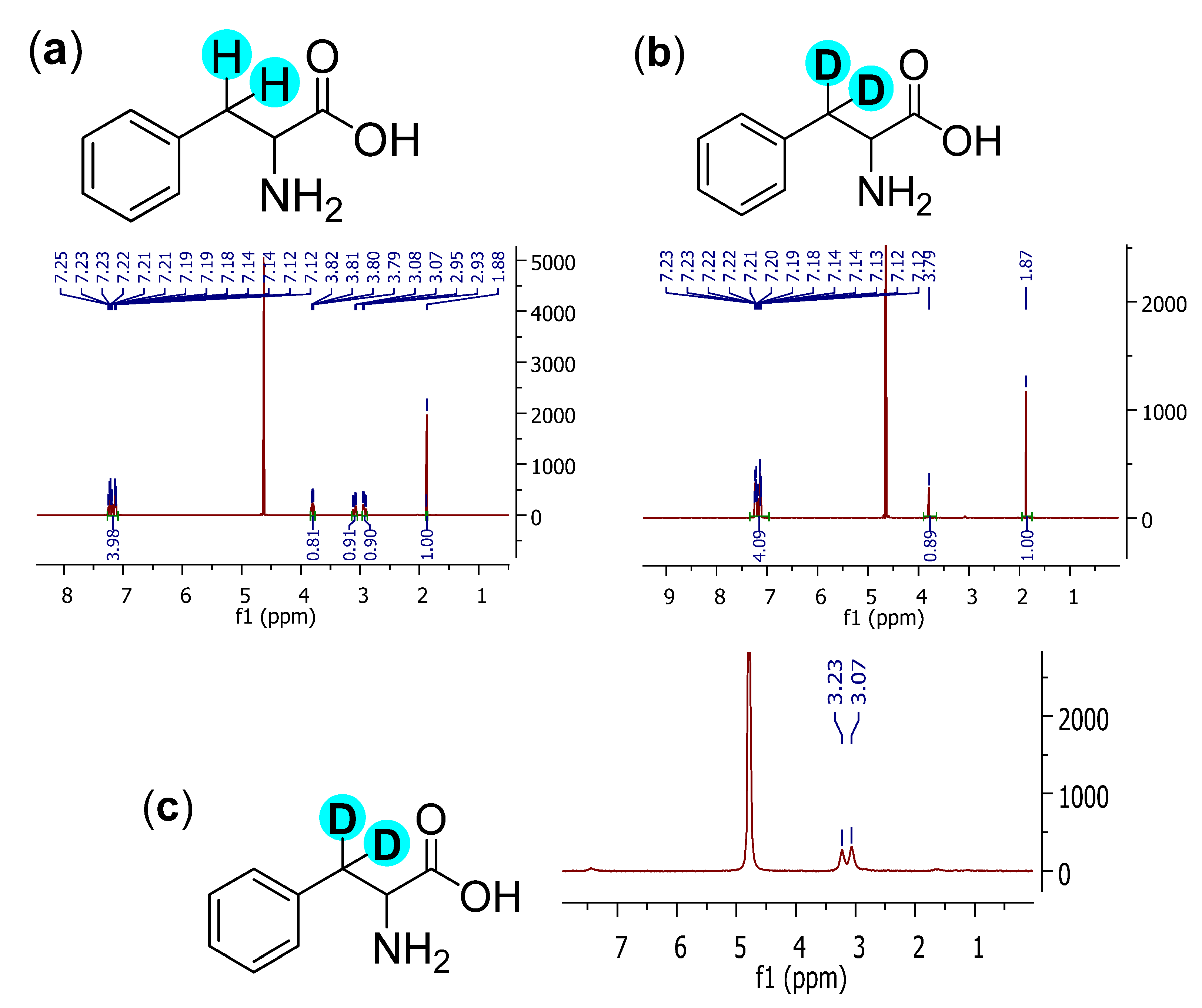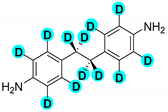Preparation of Deuterium Labeled Compounds by Pd/C-Al-D2O Facilitated Selective H-D Exchange Reactions
Abstract
:1. Introduction
2. Results and Discussion
3. Materials and Methods
3.1. General Information
3.2. Procedure
3.3. Catalyst Recycling
4. Conclusions
Supplementary Materials
Author Contributions
Funding
Institutional Review Board Statement
Informed Consent Statement
Data Availability Statement
Acknowledgments
Conflicts of Interest
Sample Availability
References
- Belleau, B.; Burba, J.; Pindell, M.; Reiffenstein, J. Effect of Deuterium Substitution in Sympathomimetic Amines on Adrenergic Responses. Science 1961, 133, 102–104. [Google Scholar] [CrossRef]
- Liu, F.; Harbeson, S.L.; Brummel, C.L.; Tung, R.; Silverman, R.D.; Doller, D. A Decade of Deuteration in Medicinal Chemistry. Annu. Rep. Med. Chem. 2017, 50, 519–542. [Google Scholar]
- Pang, X.; Wang, Y.; Chen, S.; Ding, M.; Huang, X.; Yuan, J.; She, Z. Alkaloids from the mangrove endophytic fungus Diaporthe phaseolorum SKS019. Bioorg. Med. Chem. Lett. 2017, 27, 803–807. [Google Scholar]
- Timmins, G.S. Deuterated drugs: Where are we now? Expert Opin. Ther. Pat. 2014, 24, 1067–1075. [Google Scholar] [CrossRef] [PubMed]
- Tetrabenazine-d6. Available online: https://www.scbt.com/scbt/product/tetrabenazine-d6 (accessed on 27 December 2021).
- Rodrigues, F.B.; Duarte, G.S.; Costa, J.; Ferreira, J.J.; Wild, E.J. Tetrabenazine Versus Deutetrabenazine for Huntington’s Disease: Twins or Distant Cousins? Mov. Disord. Clin. Pract. 2017, 4, 582–585. [Google Scholar] [CrossRef] [PubMed] [Green Version]
- Mullard, A. Deuterated drugs draw heavier backing. Nat.-Drug Discov. 2015, 15, 219–221. [Google Scholar] [CrossRef]
- Jacques, V.; Czarnik, A.W.; Judge, T.M.; Van der Ploeg, H.T.V.; DeWitt, S.H. Differentiation of antiinflammatory and antitumorigenic properties of stabilized enantiomers of thalidomide analogs. Proc. Natl. Acad. Sci. USA 2015, 112, 1471–1479. [Google Scholar] [CrossRef] [PubMed] [Green Version]
- Yamamoto, T.; Tokunaga, E.; Nakamura, S.; Shibata, N.; Toru, T. Synthesis and Configurational Stability of (S)- and (R)-Deuterothalidomides. Chem. Pharm. Bull. 2010, 58, 110–112. [Google Scholar] [CrossRef] [Green Version]
- Wilkinson, D.J.; Brook, M.S.; Smith, K.; Atherton, P.J. Stable isotope tracers and exercise physiology: Past, present and future. J. Physiol. 2017, 595, 2873–2882. [Google Scholar] [CrossRef] [Green Version]
- Harkiss, A.H.; Sutherland, A. Recent advances in the synthesis and application of fluorescent α-amino acids. Org. Biomol. Chem. 2016, 14, 8911–8921. [Google Scholar] [CrossRef] [Green Version]
- Oba, M.; Ohkuma, K.; Hitokawa, H.; Shirai, A.; Nishiyama, K. Convenient synthesis of deuterated glutamic acid, proline and leucine via catalytic deuteration of unsaturated pyroglutamate derivatives. J. Label. Comp. Radiopharm. 2006, 49, 229–235. [Google Scholar] [CrossRef]
- Esaki, H.; Kurita, T.; Fujiwara, Y.; Maegawa, T.; Monguchi, M.; Sajiki, H. An efficient deuteration method catalyzed by heterogeneous platinum group metals. J. Synth. Org. Chem. Jpn. 2007, 65, 1179–1190. [Google Scholar] [CrossRef]
- Esaki, H.; Aoki, F.; Umemura, M.; Kato, M.; Maegawa, T.; Monguchi, Y.; Sajiki, H. Efficient H/D Exchange Reactions of Alkyl-Substituted Benzene Derivatives by Means of the Pd/C–H2–D2O System. Chem. Eur. J. 2007, 13, 4052–4063. [Google Scholar] [CrossRef]
- Liu, M.; Chen, X.; Chen, T.; Yin, S. A facile and general acid-catalyzed deuteration at methyl groups of N-heteroarylmethanes. Org. Biomol. Chem. 2017, 15, 2507–2511. [Google Scholar] [CrossRef] [PubMed]
- Bouges, H.; Antoniotti, S. A synthesis of deuterated methyleugenol via transition metal-catalyzed coupling of substituted deuterated benzyl chloride with vinylmagnesium bromide. Flavour Fragr. J. 2017, 32, 191–195. [Google Scholar] [CrossRef]
- Rakoff, H.; Rohwedder, W. Catalytic deuteration of alkynols and their tetrahydropyranyl ethers. Lipids 1992, 27, 567–569. [Google Scholar] [CrossRef]
- Rosales, A.; Rodriguez-Garcia, I. Cp2TiCl/D2O/Mn, a formidable reagent for the deuteration of organic compounds. Beilstein J. Org. Chem. 2016, 12, 1585–1589. [Google Scholar] [CrossRef] [PubMed] [Green Version]
- Campos, J.; Espada, M.F.; Lopez-Serrano, J.; Carmona, E. Cyclometalated Iridium Complexes of Bis(Aryl) Phosphine Ligands: Catalytic C–H/C–D Exchanges and C–C Coupling Reactions. Inorg. Chem. 2013, 52, 6694–6704. [Google Scholar] [CrossRef]
- Sawama, Y.; Monguchi, Y.; Sajiki, H. Efficient H–D exchange reactions using heterogeneous platinum-group metal on carbon–H2–D2O system. Synlett 2012, 23, 959–972. [Google Scholar] [CrossRef]
- Wang, W.; Hull, J.F.; Muckerman, J.T.; Fujita, E.; Hirose, T.; Himeda, Y. Highly Efficient D2 Generation by Dehydrogenation of Formic Acid in D2O through H+/D+ Exchange on an Iridium Catalyst: Application to the Synthesis of Deuterated Compounds by Transfer Deuterogenation. Chem. Eur. J. 2012, 18, 9397–9404. [Google Scholar] [CrossRef] [PubMed]
- Ishibashi, K.; Takahashi, M.; Yokota, Y.; Oshima, K.; Matsubara, S. Ruthenium-catalyzed Isomerization of Alkenol into Alkanone in Water under Irradiation of Microwaves. Chem. Lett. 2005, 34, 664–665. [Google Scholar] [CrossRef]
- Chatterjee, B.; Krishnakumar, V.; Gunanathan, C. Selective α-Deuteration of Amines and Amino Acids Using D2O. Org. Lett. 2016, 18, 5892–5895. [Google Scholar] [CrossRef]
- Mhadgut, S.C.; Török, M.; Esquibel, J.; Török, B. Highly Asymmetric Heterogeneous Catalytic Hydrogenation of Isophorone on Proline Modified Base-Supported Palladium Catalysts. J. Catal. 2006, 238, 441–448. [Google Scholar] [CrossRef]
- Kurita, T.; Hattori, K.; Seki, S.; Mizumoto, M.; Aoki, F.; Yamada, Y.; Ikawa, K.; Maegawa, T.; Monguchi, Y.; Sajiki, H. Efficient and Convenient Heterogeneous Palladium-Catalyzed Regioselective Deuteration at the Benzylic Position. Chem. Eur. J. 2008, 14, 664–673. [Google Scholar] [CrossRef]
- Ishimoto, K.; Mitoma, Y.; Kanda, T.; Suzuki, H.; Matsuda, T.; Tashiro, M. Reduction and Reductive Preparation of Deuteriated Compounds Using Raney Ni-Al Alloy. Jpn. J. Deuterium Sci. 2001, 10, 1–10. [Google Scholar]
- Tsukinoki, T.; Tsuzuki, H.; Ishimoto, K.; Nakayama, K.; Kakinami, T.; Mataka, S.; Tashiro, M. Preparation of deuteriated benzylamines and phenethylamine with raney alloys in an alkaline deuterium oxide solution. J. Label. Comp. Radiopharm. 1994, 34, 839–844. [Google Scholar] [CrossRef]
- Tsuzuki, H.; Mukumoto, M.; Udagawa, J.; Mataka, S.; Tashiro, M. Deuterium Labelling of L-Tyrosine with Raney Alloys in Alkaline Deuterium Oxide Solutions; The Reports of Institute of Advanced Material Study; Kyushu University: Kyushu, Japan, 1997; Volume 11, pp. 121–124. [Google Scholar]
- Loh, Y.Y.; Nagao, K.; Hoover, A.J.; Hesk, D.; Rivera, N.R.; Colletti, S.L.; Davies, I.W.; MacMillan, D.W.C. Photoredox-catalyzed deuteration and tritiation of pharmaceutical compounds. Science 2017, 358, 1182–1187. [Google Scholar] [CrossRef] [Green Version]
- Orsy, G.; Fülöp, F.; Mándity, M. Continuous-flow catalytic deuterodehalogenation carried out in propylene carbonate. Green Chem. 2019, 21, 956–961. [Google Scholar] [CrossRef]
- Atzrodt, J.; Derdau, V.; Kerr, W.J.; Reid, M. C−H Functionalisation for Hydrogen Isotope Exchange. Angew. Chem. Int. Ed. 2018, 57, 3022–3047. [Google Scholar] [CrossRef]
- Kokel, A.; Schäfer, C.; Török, B. Application of microwave-assisted heterogeneous catalysis in sustainable synthesis design. Green Chem. 2017, 19, 3729–3751. [Google Scholar] [CrossRef]
- Pandey, G.; Török, B. K-10 montmorillonite-catalyzed solid phase diazotizations: Environmentally benign coupling of diazonium salts with aromatic hydrocarbons to biaryls. Green Chem. 2017, 19, 5390–5395. [Google Scholar] [CrossRef]
- Cho, H.; Schäfer, C.; Török, B. Hydrogenations and Deuterium Labeling with Aluminum-based Metal Alloys under Aqueous Conditions. Curr. Org. Synth. 2016, 13, 255–277. [Google Scholar] [CrossRef]
- Schäfer, C.; Nisanci, B.; Bere, M.P.; Dastan, A.; Török, B. Heterogeneous Catalytic Reductive Amination of Carbonyl Compounds with Ni-Al Alloy in Water as Solvent and Hydrogen Source. Synthesis 2016, 48, 3127–3133. [Google Scholar]
- Schäfer, C.; Ellstrom, C.J.; Cho, H.; Török, B. Pd/C-Al-Water Facilitated Selective Reduction of a Broad Variety of Functional Groups. Green Chem. 2017, 19, 1230–1234. [Google Scholar] [CrossRef]
- Schäfer, C.; Cho, H.; Vlocskó, R.B.; Xie, G.; Török, B. Recent Advances in the Green Synthesis of Heterocycles: From Building Blocks to Biologically Active Compounds. Curr. Org. Synth. 2022; in press. [Google Scholar] [CrossRef]
- Ilamanova, M.; Mastyugin, M.; Schäfer, C.; Kokel, A.; Török, B. Heterogeneous Metal Catalysis for the Environmentally Benign Synthesis of Medicinally Important Scaffolds, Intermediates and Building Blocks. Curr. Org. Chem. 2021, 25, 2304–2330. [Google Scholar] [CrossRef]
- Prakash, G.K.S.; Yan, P.; Török, B.; Olah, G.A. Superacid Catalyzed Hydroxyalkylation of Aromatics with Ethyl Trifluoropyruvate: A New Synthetic Route to Mosher’s Acid Analogs. Syntlett 2003, 4, 527–531. [Google Scholar] [CrossRef]
- Török, B.; Schäfer, C.; Kokel, A. Heterogeneous Catalysis in Sustainable Synthesis; Elsevier: Amsterdam, The Netherlands; Cambridge, UK; Oxford, UK, 2021. [Google Scholar]





 | ||||||||
| Entry | T (°C) | Time (h) | ∆ | Conversion (%) | H-D Exchange (%) e | |||
| DA | DB | DC | DD | |||||
| 1 | 80 | 1 | MW | 55 | 55 | 20 | 0 | 0 |
| 2 | 80 | 1 | MW b | 0 | 0 | 0 | 0 | 0 |
| 3 | 80 | 24 | CH | 100 | 100 | 75 | 0 | 15 |
| 4 | 100 | 1 | MW | 75 | 75 | 30 | 0 | 0 |
| 5 | 120 | 1 | MW | 100 | 100 | 100 | 0 | 0 |
| 6 | 120 | 0.5 | MW | 100 | 100 | 100 | 0 | 0 |
| 7 | 120 | 1 | MW c | 100 | 100 | 100 | 0 | 0 |
| 8 | 120 | 0.5 | MW d | 35 | 35 | 0 | 0 | 0 |
| Entry | Product | Time (min) | T (°C) | Conversion b,c (%) | ED d (%) |
|---|---|---|---|---|---|
| 1 |  | 30 | 120 | 100 | >99 |
| 2 |  | 60 | 170 | 90 | 90 |
| 3 |  | 20 | 120 | 95 | 95 |
| 4 |  | 60 | 190 | 60 | 60 |
| 5 |  | 20 | 60 | 100 | >99 |
| 6 |  | 60 | 120 | 100 | >99 |
| 7 |  | 60 | 80 | 80 | 80 |
| 8 |  | 60 | 100 | 100 | >99 |
| 9 |  | 60 | 80 | 80 | 80 |
| 10 |  | 60 | 120 | 100 | DA: 76 DB: 99 |
Publisher’s Note: MDPI stays neutral with regard to jurisdictional claims in published maps and institutional affiliations. |
© 2022 by the authors. Licensee MDPI, Basel, Switzerland. This article is an open access article distributed under the terms and conditions of the Creative Commons Attribution (CC BY) license (https://creativecommons.org/licenses/by/4.0/).
Share and Cite
Kokel, A.; Kadish, D.; Török, B. Preparation of Deuterium Labeled Compounds by Pd/C-Al-D2O Facilitated Selective H-D Exchange Reactions. Molecules 2022, 27, 614. https://doi.org/10.3390/molecules27030614
Kokel A, Kadish D, Török B. Preparation of Deuterium Labeled Compounds by Pd/C-Al-D2O Facilitated Selective H-D Exchange Reactions. Molecules. 2022; 27(3):614. https://doi.org/10.3390/molecules27030614
Chicago/Turabian StyleKokel, Anne, Dora Kadish, and Béla Török. 2022. "Preparation of Deuterium Labeled Compounds by Pd/C-Al-D2O Facilitated Selective H-D Exchange Reactions" Molecules 27, no. 3: 614. https://doi.org/10.3390/molecules27030614
APA StyleKokel, A., Kadish, D., & Török, B. (2022). Preparation of Deuterium Labeled Compounds by Pd/C-Al-D2O Facilitated Selective H-D Exchange Reactions. Molecules, 27(3), 614. https://doi.org/10.3390/molecules27030614





